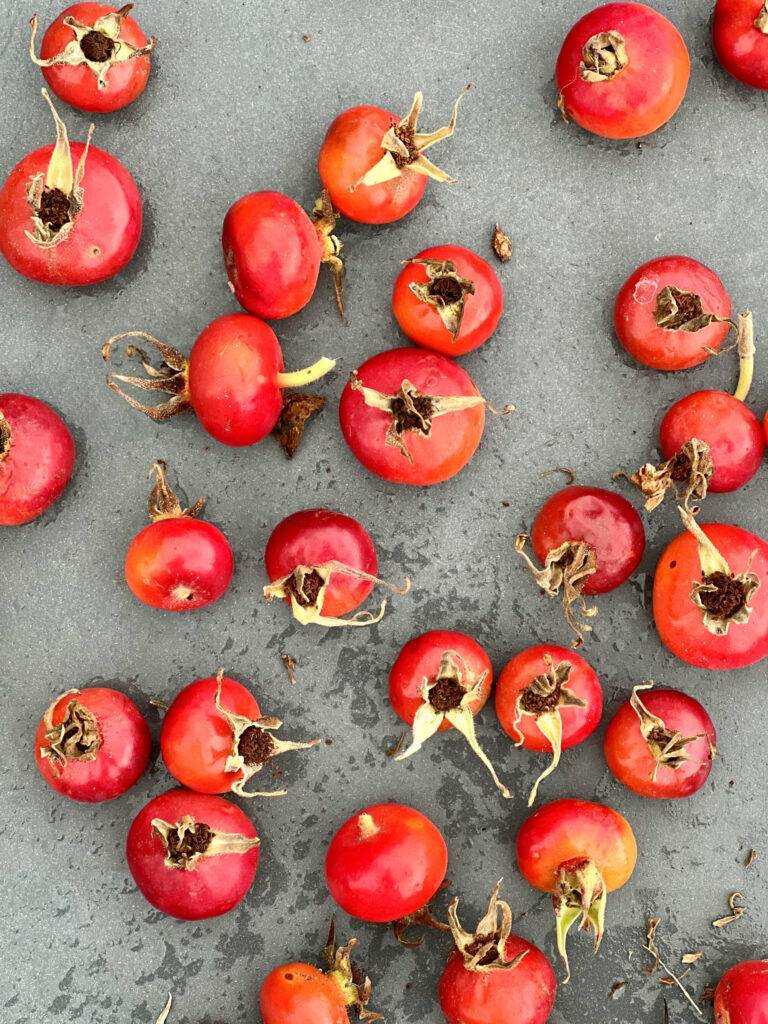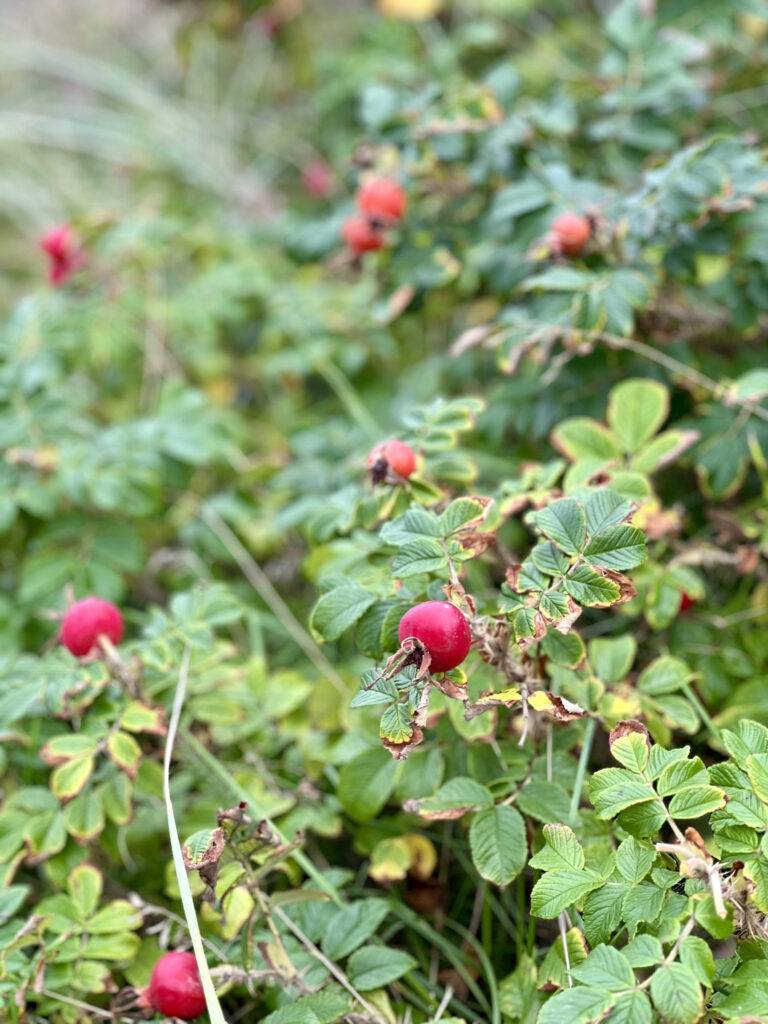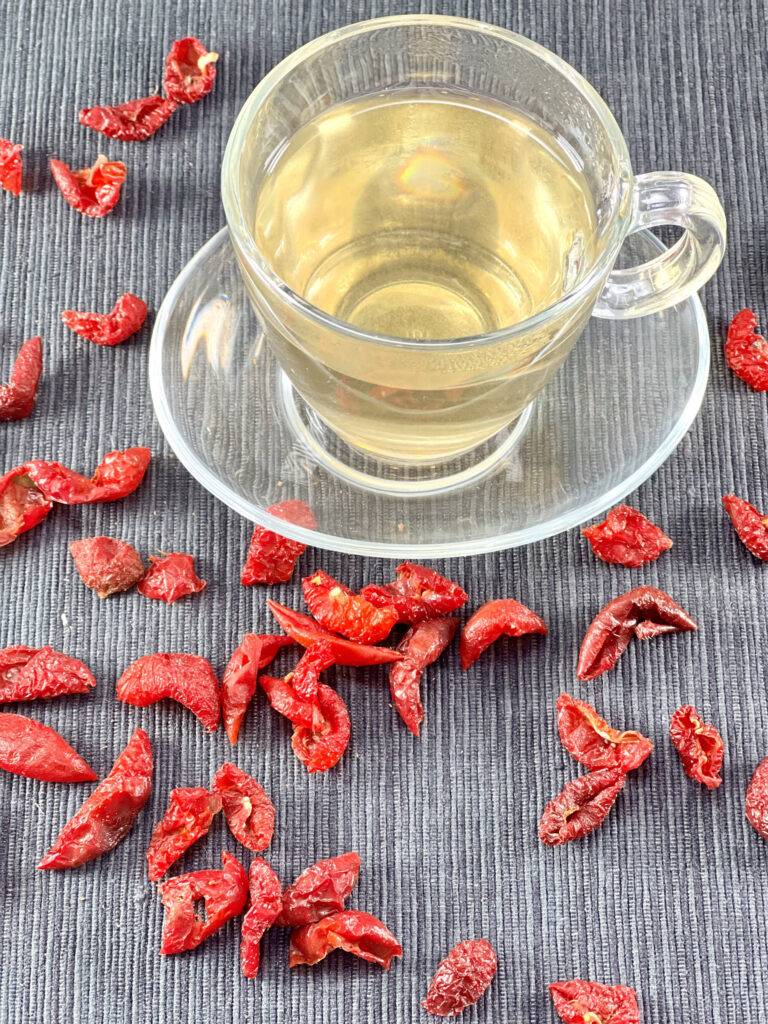
Rose hip tea is a delicious infusion full of autumn and winter flavors. The tea is slightly tangy and has delicious fruity and mild floral notes. You can easily make rose hip tea after foraging rose hips if you live in an area where they grow. You can dry and preserve them, so you can have this delicious tea during the cold season when you crave it.
What are Rose Hips

Rose hips are the accessory fruit of the rose species. They ripen in the late summer and autumn months and have a distinct orange-to-red color. Aside from their edible flesh, rose hips contain seeds and hairs. While you can eat the fruits, be careful not to consume the hairs and seeds, as they can cause irritation. The hairs can even be used as itching powder. The rose hips are also commonly used for cosmetic purposes, where the oil is extracted from the seeds. The rose hip flesh has a mild, slightly tangy, floral taste. They are used in recipes, especially in Scandinavia and Eastern Europe.

If I am not using the rose hips for tea, I love making rose hip jam or rose hip soup. It is delicious!
How to Process Rose Hips for Tea:
Foraging Rose Hips:
While you can buy dried rose hips online to make this tea, I will give you some tips on how to forage and dry them yourself. They grow in abundance in many regions, so there is a good chance you can find them yourself. Foraging is fun and cheap, and cooking with self-foraged ingredients always tastes best! Also, all rose hips are edible. So, as long as you identify this distinct-looking fruit correctly, you are good to go to make your rose hip tea.
I collected mine during a vacation in Denmark, where the species Rosa Rugosa grows in abundance close to the coastline. Rosa Rubiginosa or Rosa Canina are two other super flavorful species that make a delicious tea. I like the Rosa Rugosa, as its big fruits make the preparation easy. I recommend foraging rose hips that are not at peak ripeness. I find them best for tea if they are still firm to the touch and of a nice red. They have some more tang, which is delicious in the tea. Also, they are way easier to process at this stage.
Preparing the Rose Hips:

If you have foraged your rose hips, give them a thorough wash. Next, remove the dark top and stem. Cut the rose hips in half and discard the seeds and hairs. I find it most convenient to use a teaspoon to carve the seeds and hairs out. I like to give them another good rinse to remove any remaining hairs. I prefer preparing the rose hips like this so no annoying hairs or seeds float in the final tea that would need to be strained out. Also, the rose hips dry the best when prepared this way.
Drying the Rose Hips
Once you prepared the rose hips, you are ready to dry them. If you are not in a rush, I recommend pre-drying them at a low temperature in the oven and air-drying them afterward. Taking the extra time could help preserve some of their healthy vitamin C.

I spread them on a baking sheet and kept them in the oven at about 50° C (122 F) for 5-6 hours. Then, I turned it off and kept them in the warm oven overnight. Once they had lost some of their water content, I dried them over five days at room temperature and gave them a toss every day. If you are in a rush, you can continue drying them in the oven, even at higher temperatures, to speed up the process. Doing so might affect the taste and nutritional quality of the tea.
How to make Rose Hip Tea:
Once you have your dried rose hips, making the tea is easy. I like steeping my rose hips in hot water (80° C / 180F) for 15-20 minutes. You can also infuse hot water with the rose hips overnight and warm it up the next day if you want a more intense flavor.

Also, rose hips can be combined nicely with other ingredients for infusions. For example, a typical mix for a winter tea includes hibiscus. You can also add rose petals for a more floral flavor.
If you like, you can sweeten the tea with a sweetener of your choice. I enjoy keeping it plain, as the tea has such a beautiful natural acidity.
And that’s all there is to this simple rose hip tea. I hope you like it. To me, this tea is the perfect caffeine-free beverage on a cold winter evening.
Some more Recipe Inspirations:
- Sea buckthorn tea
- Masala chai
- Lavender milk tea
- Hot spiced apple juice
- Spicy orange mint tea
- Sea buckthorn jam
- Dirty chai latte
Rose Hip Tea FAQ:
No, rose hip tea does not contain any caffeine.
You can harvest rose hips during late summer and autumn. I’d suggest using red rose hips, but not peak ripe, and still a bit firm to the touch.
If you use whole rose hips, pour the steeped tea through a cheesecloth or coffee filter. Using whole rose hips is an easy way to make the tea, especially when using fresh rose hips. Otherwise, I like preparing the rose hips by slicing them in half and discarding the hairs and seeds before drying them.
Yes, all rose hips are edible. I’d recommend Rosa Rugosa, as it has big and tasty fruit. Rosa Rubiginosa or Rosa Canina are great options as well.

Rose Hip Tea Recipe
Rose hip tea is a delicious infusion. It is super simple to make and you can forage the rose hips yourself. It is a tangy, mild and floral tea that is just the right for the cold months.
- Total Time: 20 minutes
- Yield: 4 servings 1x
Ingredients
Instructions
Add the dried rose hips to a pot or tea can.
Allow the rose hips to steep in 80° C / 180° F water for 15-20 minutes.
Notes
You can also steep the infusion overnight and warm the next day for a more intense flavor.
- Cook Time: 20 minutes
- Category: Tea, Hot Beverage
- Cuisine: International
- Diet: Vegan
